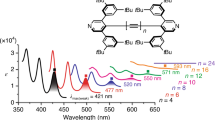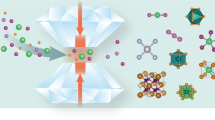Abstract
Steric effects in chemistry are a consequence of the space required to accommodate the atoms and groups within a molecule, and are often thought to be dominated by repulsive forces arising from overlapping electron densities (Pauli repulsion). An appreciation of attractive interactions such as van der Waals forces (which include London dispersion forces) is necessary to understand chemical bonding and reactivity fully. This is evident from, for example, the strongly debated origin of the higher stability of branched alkanes relative to linear alkanes1,2 and the possibility of constructing hydrocarbons with extraordinarily long C–C single bonds through steric crowding3. Although empirical bond distance/bond strength relationships have been established for C–C bonds4 (longer C–C bonds have smaller bond dissociation energies), these have no present theoretical basis5. Nevertheless, these empirical considerations are fundamental to structural and energetic evaluations in chemistry6,7, as summarized by Pauling8 as early as 1960 and confirmed more recently4. Here we report the preparation of hydrocarbons with extremely long C–C bonds (up to 1.704 Å), the longest such bonds observed so far in alkanes. The prepared compounds are unexpectedly stable—noticeable decomposition occurs only above 200 °C. We prepared the alkanes by coupling nanometre-sized, diamond-like, highly rigid structures known as diamondoids9. The extraordinary stability of the coupling products is due to overall attractive dispersion interactions between the intramolecular H•••H contact surfaces, as is evident from density functional theory computations with10 and without inclusion of dispersion corrections.
This is a preview of subscription content, access via your institution
Access options
Subscribe to this journal
Receive 51 print issues and online access
$199.00 per year
only $3.90 per issue
Buy this article
- Purchase on Springer Link
- Instant access to full article PDF
Prices may be subject to local taxes which are calculated during checkout


Similar content being viewed by others
References
Grimme, S. Seemingly simple stereoelectronic effects in alkane isomers and the implications for Kohn–Sham density functional theory. Angew. Chem. Int. Ed. 45, 4460–4464 (2006)
Wodrich, M. D. et al. The concept of protobranching and its many paradigm shifting implications for energy evaluations. Chem. Eur. J. 13, 7731–7744 (2007)
de Silva, K. M. N. & Goodman, J. M. What is the smallest saturated acyclic alkane that cannot be made? J. Chem. Inf. Model. 45, 81–87 (2005)
Zavitsas, A. A. The relation between bond lengths and dissociation energies of carbon-carbon bonds. J. Phys. Chem. A 107, 897–898 (2003)
Kaupp, M., Metz, B. & Stoll, H. Breakdown of bond length-bond strength correlation: a case study. Angew. Chem. Int. Ed. 39, 4607–4609 (2000)
Gordy, W. A relation between bond force constants, bond orders, bond lengths, and the electronegativities of the bonded atoms. J. Chem. Phys. 14, 305–320 (1946)
Huggins, M. L. Atomic radii. IV. Dependence of interatomic distance on bond energy. J. Am. Chem. Soc. 75, 4126–4133 (1953)
Pauling, L. The Nature of the Chemical Bond (Cornell Univ. Press, 1960)
Schwertfeger, H., Fokin, A. A. & Schreiner, P. R. Diamonds are a chemist’s best friend: diamondoid chemistry beyond adamantane. Angew. Chem. Int. Ed. 47, 1022–1036 (2008)
Grimme, S. Accurate description of van der Waals complexes by density functional theory including empirical corrections. J. Comput. Chem. 25, 1463–1473 (2004)
Tang, K.-T. & Toennies, J. P. Johannes Diderik van der Waals: a pioneer in the molecular sciences and Nobel prize winner in 1910. Angew. Chem. Int. Ed. 49, 9574–9579 (2010)
Gronert, S. The folly of protobranching: turning repulsive interactions into attractive ones and rewriting the strain/stabilization energies of organic chemistry. Chem. Eur. J. 15, 5372–5382 (2009)
Suzuki, T., Takeda, T., Kawai, H. & Fujiwara, K. Ultralong C–C bonds in hexaphenylethane derivatives. Pure Appl. Chem. 80, 547–553 (2008)
Fritz, G., Wartanessian, S., Matern, E., Hönle, W. & von Schnering, H. G. Bildung siliciumorganischer Verbindungen. 85. Bildung, Reaktionen und Struktur des 1,1,3,3-tetramethyl-2,4-bis(trimethylsilyl)-1,3-disilabicyclo[1.1.0]butans. Z. Allg. Anorg. Chem. 475, 87–108 (1981)
McBride, J. M. The hexaphenylethane riddle. Tetrahedron 30, 2009–2022 (1974)
Vreven, T. & Morokuma, K. Prediction of the dissociation energy of hexaphenylethane using the ONIOM(MO: MO: MO) method. J. Phys. Chem. A 106, 6167–6170 (2002)
Kahr, B., van Engen, D. & Mislow, K. Length of the ethane bond in hexaphenylethane and its derivatives. J. Am. Chem. Soc. 108, 8305–8307 (1986)
Kammermeier, S., Jones, P. G. & Herges, R. [2+2] cycloaddition products of tetradehydrodianthracene: experimental and theoretical proof of extraordinary long C–C single bonds. Angew. Chem. Int. Edn Engl. 36, 1757–1760 (1997)
Winiker, R., Beckhaus, H. D. & Rüchardt, C. Thermische Stabilität, Spannungsenthalpie und Struktur symmetrisch hexaalkylierter Ethane. Chem. Ber. 113, 3456–3476 (1980)
Flamm-ter Meer, M. A., Beckhaus, H. D., Peters, K., von Schnering, H. G. & Rüchardt, C. Thermolabile hydrocarbons, XXVII. 2,3-di-1-adamantyl-2,3-dimethylbutane; long bonds and low thermal stability. Chem. Ber. 118, 4665–4673 (1985)
Rüchardt, C. & Beckhaus, H. D. Towards an understanding of the carbon-carbon bond. Angew. Chem. Int. Edn Engl. 19, 429–440 (1980)
Rüchardt, C. & Beckhaus, H.-D. Consequences of strain for the structure of aliphatic molecules. Angew. Chem. Int. Edn Engl. 24, 529–538 (1985)
Boese, R., Weiss, H.-C. & Bläser, D. The melting point alternation in the short-chain n-alkanes: single-crystal X-ray analyses of propane at 30 K and of n-butane to n-nonane at 90 K. Angew. Chem. Int. Ed. 38, 988–992 (1999)
Grimme, S. et al. When do interacting atoms form a chemical bond? Spectroscopic measurements and theoretical analyses of dideuteriophenanthrene. Angew. Chem. Int. Ed. 48, 2592–2595 (2009)
Donohue, J. & Goodman, S. H. The crystal structure of adamantane: an example of a false minimum in least squares. Acta Crystallogr. 22, 352–354 (1967)
Zhao, Y. & Truhlar, D. G. The M06 suite of density functionals for main group thermochemistry, thermochemical kinetics, noncovalent interactions, excited states, and transition elements: two new functionals and systematic testing of four M06-class functionals and 12 other functionals. Theor. Chem. Acc. 120, 215–241 (2008)
Takatani, T. & Sherrill, C. D. Performance of spin-component-scaled Moller-Plesset theory (SCS-MP2) for potential energy curves of noncovalent interactions. Phys. Chem. Chem. Phys. 9, 6106–6114 (2007)
Maier, G., Pfriem, S., Schäfer, U. & Matusch, R. Tetra-tert-butyltetrahedrane. Angew. Chem. Int. Edn Engl. 17, 520–521 (1978)
Wang, Y. Z. & Robinson, G. H. Unique homonuclear multiple bonding in main group compounds. Chem. Commun. (Camb.) 5201–5213 (2009)
Dyker, C. A. & Bertrand, G. Soluble allotropes of main-group elements. Science 321, 1050–1051 (2008)
Becke, A. D. Density-functional thermochemistry. III. The role of exact exchange. J. Chem. Phys. 98, 5648–5652 (1993)
Lee, C. T., Yang, W. T. & Parr, R. G. Development of the Colle-Salvetti correlation-energy formula into a functional of the electron-density. Phys. Rev. B 37, 785–789 (1988)
Grimme, S. Semiempirical GGA-type density functional constructed with a long-range dispersion correction. J. Comput. Chem. 27, 1787–1799 (2006)
Schwabe, T. & Grimme, S. Towards chemical accuracy for the thermodynamics of large molecules: new hybrid density functionals including non-local correlation effects. Phys. Chem. Chem. Phys. 8, 4398–4401 (2006)
Becke, A. D. Density-functional thermochemistry. V. Systematic optimization of exchange-correlation functionals. J. Chem. Phys. 107, 8554–8560 (1997)
Binkley, J. S., Pople, J. A. & Hehre, W. J. Split valence basis sets. J. Am. Chem. Soc. 102, 939–947 (1980)
Frisch, M. J. et al. Gaussian 03 v.D.02 (Gaussian, Inc., 2003)
Frisch, M. J. et al. Gaussian09 v.B.01 (Gaussian, Inc., 2009)
Acknowledgements
We thank S. Grimme for providing an implementation of his dispersion correction technique and for discussions. We are grateful for support from the Deutsche Forschungsgemeinschaft and the National Science Foundation of the USA, and in part from the Department of Energy, Office of Basic Energy Sciences, Division of Materials Science and Engineering, under contract DE-AC02-76SF00515; the Ministry of Science and Education of Ukraine; and the Ukrainian State Basic Research Fund.
Author information
Authors and Affiliations
Contributions
P.R.S. and A.A.F. formulated the initial working hypothesis and provided, analysed and interpreted all experimental data. L.V.C, P.A.G. and E.Yu.T. carried out the coupling experiments. H.H. recorded and analysed all NMR data. M.S. solved all X-ray structures. S.S. provided and interpreted the DSC and TGA analyses. J.E.P.D. and R.M.K.C. isolated and purified the diamondoids. The manuscript was written by P.R.S. and A.A.F.
Corresponding authors
Ethics declarations
Competing interests
The authors declare no competing financial interests.
Additional information
X-ray crystal structures have been deposited in the Cambridge Crystallographic Database under the deposition numbers CCDC 805315 (7•7), CCDC 806293 (6•8) and CCDC 806294 (7•8).
Supplementary information
Supplementary Information
This file contains Supplementary Figures 1-14 with legends, Supplementary Methods and Data, Supplementary Tables 1-3 and additional references. (PDF 5587 kb)
PowerPoint slides
Rights and permissions
About this article
Cite this article
Schreiner, P., Chernish, L., Gunchenko, P. et al. Overcoming lability of extremely long alkane carbon–carbon bonds through dispersion forces. Nature 477, 308–311 (2011). https://doi.org/10.1038/nature10367
Received:
Accepted:
Published:
Issue Date:
DOI: https://doi.org/10.1038/nature10367
This article is cited by
-
A light-driven enzymatic enantioselective radical acylation
Nature (2024)
-
DFT study on binding of single and double methane with aromatic hydrocarbons and graphene: stabilizing CH…HC interactions between two methane molecules
Structural Chemistry (2021)
-
Polarizability and isotope effects on dispersion interactions in water
Communications Chemistry (2019)
-
Hybrid metal–organic chalcogenide nanowires with electrically conductive inorganic core through diamondoid-directed assembly
Nature Materials (2017)
-
London dispersion forces in sterically crowded inorganic and organometallic molecules
Nature Reviews Chemistry (2017)
Comments
By submitting a comment you agree to abide by our Terms and Community Guidelines. If you find something abusive or that does not comply with our terms or guidelines please flag it as inappropriate.



